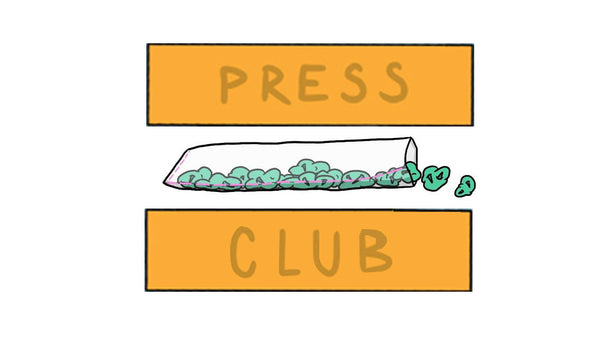Top 5 Rosin Pressing Tips For Flower


Todde Philips
🇺🇸 Retired veteran, father, rock-climbing expert & rosin connoisseur
✅ Updated 8/15/21
Hours of experimentation lead to lots of valuable insights when you’re pressing flower rosin. We’ve captured a few of our favorites here.
Quality In, Quality Out
The quality of rosin you collect is determined primarily by the quality of the flower you’re pressing. Given that your press is dialed-in, any shortcomings in your rosin can most likely be traced back to shortcomings in your flower. The importance of excellent material can’t be understated if your goal is truly connoisseur rosin. In essence, if you want to improve the quality of your rosin, look first to improve the quality of your material.
Also keep in mind that quality and freshness tend to be interconnected. Aim to press your material just after the flowers have been dried and cured properly. Longer cures and excessive dryness can lead to darker results at the press.
How well the plants were cared for during growth and flowering has more of an impact on your final product than the growing medium used. There doesn’t seem to be any difference in flower rosin from soil, hydro, or coco, however some strains tend to produce flowers more readily pressed into high-yield rosin than others.
You can read about some of the best strains for pressing rosin here.
Expect chunky indicas and robust hybrids to yield more than the airy sativas. The resin production on the flowers determines the yields at the press, and don’t forget that genetics play a critical role. Using strains that are known for their potency and production will ultimately lead to more rosin dripping onto your parchment paper.
Master the Microns
Using filter bags is standard practice for most seasoned extractors. While bags aren’t absolutely necessary to press flower rosin, they are the best way to prevent tiny pieces of plant material from getting mixed in with your final product. However it’s not enough to keep one micron screen size for all purposes. The goal is to maximize both quality and quality in parallel, and properly selecting the correct micron for the job is crucial.
90 microns is a good standard for pressing flower. Less than that and you start losing out on yields for only minimal increases in quality. For flower, 90 microns is an excellent choice when optimizing for quality without losing much yield. Even 75 and 50 micron bags will work for flower rosin, with some loss to yield in order to get less lipids and other contaminants in the rosin.
120-160 microns is the largest size rosin bags for flower rosin, as above the this size of filter screen you’re sacrificing purity and overall quality of the final product as unwanted material is forced through the screen.
90-120 microns gives you a good balance between yield and quality, for the times you want to optimize the total output from your material.

The material of the rosin bags is a key consideration, as various materials perform differently with exposure to heat and pressure. Additionally, the way a specific micron performs in the press is dependent on material, since higher micron counts allow more material to pass through.
Stainless steel can hack into your yields and silk has too much stretch to be able to effectively track pressure. The ideal material is 100% Food Grade Nylon [link] for your bags, regardless of micron width.
Check the Moisture
Very dry flowers are like sponges. They’re thirsty for moisture and all-too-quick to soak up the quality rosin you’ve worked so hard to extract. With ultra dry flowers in the press, once the trichomes and oils begin to heat and separate from the plant matter, rather than flowing out of the flower and through your bag they’re reabsorbed into the super dry material and never make it out to your parchment. Needless to say, this has a significantly negative impact on your yield, as you don’t want your flower retaining the product.
So how do you know how dry is too dry? Before you start pressing the flowers, make sure that the relative humidity content of the buds is 55-62%. This is the range you should aim for to ensure the maximum amount of rosin will separate out of the flowers. You can use an analog hygrometer (found in cigar boxes) to read the relative humidity, or spend $25 on a digital Caliber IV hygrometer. This modest investment pays dividends and is the best way to go.
If you need to rehydrate cannabis flowers for pressing rosin, we wrote an article that gives you the best ways to do it here.
More Might Is Not Always Right
Although flower rosin requires more pressure than kief or hash, assuming that more pressure invariably leads to better results is a mistake. There is a point of diminishing returns which you'll often have to find through experimentation. The ideal pressure range for flower rosin is somewhere between 1000-2000 PSI at the plate. For us, maximum quality runs at the low end of that spectrum.
There are plenty of presses that easily generate more pressure, but the point of diminishing returns falls well below the max pressure that many presses on the market are generating. With too much pressure, your rosin will likely contain particulates and unbeneficial plant oils.
Here’s how to calculate your pressure: take the total force your press exerts and divide that number by the total square inch footprint of the bag (as opposed to the total square inch of the whole plate). The standard method of measuring pressure is actually another point of contention, which you can find out more about in this article about How To Calculate Platen PSI.
High quality flower with the proper moisture level (62% Relative Humidity) pressed in high quality rosin bags at 1500 PSI can yield around 20-25% (or more).
We created an Ultimate Guide to Pressure for Rosin production if you want to go more in-depth into the topic of pressure.

Tweak Temps to Customize Your Results
Discussions about temperature generally divide rosin enthusiasts into two camps: Cold Pressing and Hot Pressing. There are advantages to both approaches, and both sides offer compelling arguments for their preferred temperature.
The temperature of your press and the distribution of heat both dictate the speed and consistency with which your flower produce rosin. Whether you’re pressing flower, kief, or hash, there are two workable temperature ranges that you can experiment with:
Cold Pressing: 180°F - 200°F pressed between one to four minutes. This setting often produces a budder or batter-like product. This temperature range optimizes terpene preservation sometimes at the expense of lesser yield.
Hot Pressing: 200°F - 220°F pressed between 45 seconds and three minutes. This setting frequently produces oily or shatter-like consistency. You can expect high terpene preservation if you don’t exceed 220°F and with the added benefit of increased in yields.
The sweet spot for us between overall quality and yield is around 210°F. If terpene preservation and quality is your #1 goal, you should probably start colder and evaluate your results, however we have observed very little terpene loss in that range. Anything above 210°F can bolster yields, however you’ll likely notice reduction in flavor and terpenes.
To drill down further into the topic of temperature and rosin extraction, check out our Ultimate Guide to Temperatures for Rosin Production.
Our advice: measure your methods and results, continue to experiment, and see what works best for you. We created a note-taking template for you to use during rosin extraction, in our guide to taking notes for better rosin extraction.
Conclusion
We love the ability that high quality flowers give us to create a rosin that preserves valuable terpene content while creating a truly unique expression of the cannabis plant.
As the knowledge that our community collectively holds continues to expand and accelerate, we’re excited by the constant experimentation and innovation that occurs. If something from your experience would lend itself to the tips and tricks above, we’d love to hear from you in the comments.
Read more about how to press exceptional flower rosin in our ultimate guide on How To Press Flower Rosin.
Thoughts? Let us know by joining our secret Facebook group. Hang out with a community of like-minded solventless heads like yourself. Ask our head extractor questions, share your latest press and learn from hobbyists and experts in the industry.
FREQUENTLY ASKED QUESTIONS
What is cold pressing?
Cold pressing is pressing rosin at 180°F - 200°F between one to four minutes. This setting often produces a budder or batter-like product. This temperature range optimizes terpene preservation sometimes at the expense of lesser yield.
What is hot pressing?
Hot pressing is 200°F - 220°F pressed between 45 seconds and three minutes. This setting frequently produces oily or shatter-like consistency. You can expect high terpene preservation if you don’t exceed 220°F and with the added benefit of increased in yields.
What is the best pressure to use for pressing flower rosin?
The ideal pressure range for flower rosin is somewhere between 1000-2000 PSI at the plate. Learn how to calculate platen PSI.
What is the best size micron rosin bag to use for flower rosin?
Anywhere from 90-160 microns is a good range to use for pressing flower rosin.
What if you press flowers that are too dry?
Pressing flowers that don't contain enough moisture will have a negative impact on yield. However, you don't want too much moisture either, that will have a negative impact on quality. The best moisture content is 60-65% relative humidity. You can put the flowers in a sealed jar with a digital hygrometer to check for moisture levels.






3 comments
My dabpress 6 ton does the trick and fair priced!
Dabpress.com
I like to push 7g using the pick mould and pre press then slid it in a 90u bag above.
Quality in quality out
I’ve been trying to find a good rosin press at a reasonable price and I want to become a great rosin maker. If I could get any advise that would be great and helpful. I can’t figure out which rosin press to get as a beginner who advances quickly
I press @140F for 60 seconds (2 presses) with 7g, which yields the same (for me) as 220F for 60 seconds. Is this because I don’t have dispensary buds? My average yield is 21%.
I’m going to try watching my pressure more and experiment with the formula given, but my best quality so far after 400+ presses on my Dulytek DHP7 has easily been at 140F for 60 seconds. After a 100F heat treat for no longer than an hour it has buttered with over a dozen strains 100% of the time. Thanks for the tips!